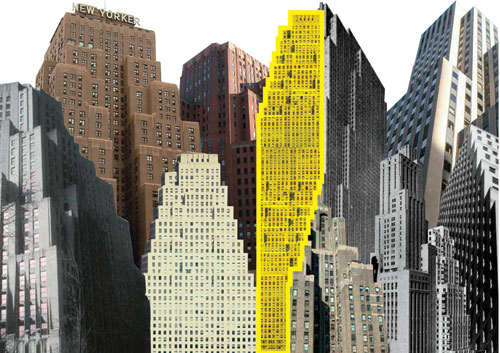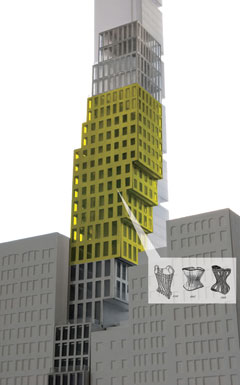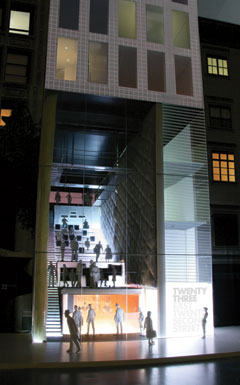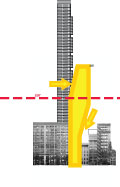Tall Buildings Push Limits by Stepping Up, Not Back
The 355-foot-tall OMA building would tower over its neighbors on 22nd Street, a mostly residential block lined with a mix of 10- to 12-story structures and smaller town houses in the shadow of the Flatiron Building. The original motivation for the growth spurt in the OMA building's midsection was to provide a good mix of apartment units-a total of 18 luxury units, including several duplexes and terraces-with varying floor plans and ceiling heights. OMA's initial design included a much more dramatic cantilever. Working from the earliest stages of design development with structural engineers at WSP Cantor Seinuk, however, OMA modified that element so that the cantilever became more gradual. The first cantilever, on the seventh floor, where the building sets back slightly, is the greatest, at 10 feet 5 inches, with successive ones above it stepping out at every other floor for a total overhang of 30 feet 8 inches above the adjacent five-story town house to the east. (The developer purchased air rights from a number of nearby properties.)
 |
OMA's project puts a modern twist on New York's historic setback buildings. |
Â
|
Spanning 10 floors of the 24-story building, the cantilever resembles an inverted staircase. At such a scale, the daring design is impressive, but the concept is an ancient one. In a corbel, which predates vaults, a block or brick is partially embedded in a wall, with one end projecting out from the face. The weight of added masonry above stabilizes the cantilever and keeps the block from falling out of the wall. The same theory holds true for this building, though steel plates are added at each of the cantilevered floors to counter overturning due to lateral, or wind, forces. In the absence of such forces, the building would be completely stable without additional support because of plans to use post-tensioning cables to anchor it into the bedrock.
The primary structure of the building, however, is not steel but concrete. The facades are composed of 12-inch-thick, high-strength structural concrete and act as sheer walls (thinning out to 10 inches above the 21st floor). The structural strategy can alternately be described as a tube with punched-out window openings or a series of stacked Vierendeel trusses that form a tube. "The structure fits nicely with the architecture," explains Silvian Marcus, C.E.O. of WSP Cantor Seinuk. "Because the floor area is so small, putting the structure in the perimeter keeps the interiors free of columns. It also suits the architects' desire for varied fenestration."
 |
 |
23 East 22nd Street's facade acts as a structural corset, with compression forces greatest at the middle (left). At the building's base is a 46-foot-tall, column free screening room (right). |
|
Â
In fact, the vertical window openings, which mimic those of nearby buildings, play a significant structural role. The size of the openings correlates to moments of stress. In areas under greatest stress, the window spacing is modified to provide increased structural area and rigidity, supporting the building like a structural corset. In the tower's midsection, where the forces generated by the cantilevers are greatest, openings are smallest. There, ceiling heights are also at their lowest at 11 feet. Where forces are minimal, as at the top of the building, ceiling heights increase to 15 feet, and openings get bigger, creating loftlike interiors. All of the forces from the upper part of the building travel down the east and west side walls to the building's base, where a 46-foot-tall, column-free screening room for the Creative Artists Agency is located. The box-in-box construction at the base acoustically isolates the screening room from the apartments. Adds Long, "In some ways, the base is more complicated structurally than the cantilever above."










